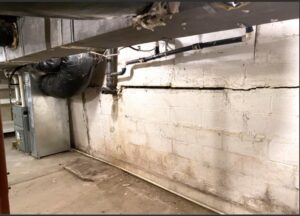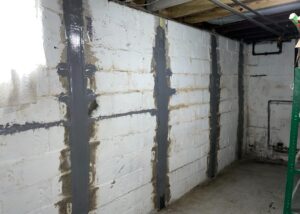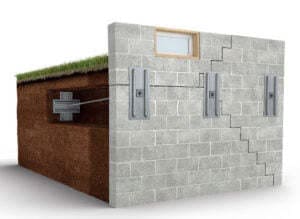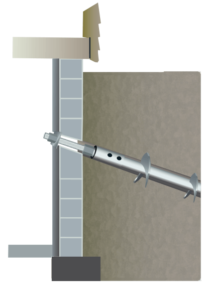What Is the Best Way to Repair a Bowed Wall?

You may not immediately realize that one of your basement walls is bowing. It’s usually a slow, gradual process that often first displays as cracks in the wall.
A bowed or buckling wall is a critical concern because it threatens the structural integrity of your home. Your entire house is relying on the strength of your foundation. If a bowing wall is not repaired, it will eventually collapse.

This photo was taken by an Acculevel project advisor during a free home assessment. The wall is clearly bulging inward.
Of course, once a foundation wall collapses, your home suffers severe structural damage. Your home is now exposed to the elements like rain, mud, and wind — and worse these things can freely intrude into your basement. Once the main floor of your home is no longer adequately supported, walls in the rest of your home will lean, floors will droop, pipes will strain and burst… essentially, your home will no longer be safe to live in and your foundation will need to be rebuilt.
At Acculevel, we’re not trying to use “scare tactics” to frighten you; we genuinely want to help you prevent this from happening to your home. We occasionally meet homeowners experiencing this type of situation, and we wouldn’t wish it on anyone!
Acculevel Can Help
We are foundation repair experts, and we’ve helped more than 30,000 homeowners in the Midwest. Acculevel is a family-owned and operated company that has been repairing, securing, and even straightening bowed or buckling walls since 1996.
Let’s explore some common signs that your wall is beginning to bow, what causes this type of structural damage, and the three major repair methods designed to repair bowing walls.
One caveat: all of the methods described in this article are designed for use on concrete foundations. Stone and brick walls need to be repaired by a masonry expert.
What Are Signs of a Bowing Wall?
Be on guard for interior cracks in your foundation. These can be long horizontal cracks or a stair-step design that follows the mortar between the blocks. Below is a picture where you can see both types of cracks.

This picture was taken by an Acculevel project advisor during a free home appointment.
These cracks may be letting in water, but water intrusion by itself isn’t a symptom. The type of crack and gradual wall movement are the major warning signs.
What Causes Bowing Walls?
If we want to be technical, lateral force is what causes a wall to bow or bulge. What does that mean to the average homeowner? Lateral force simply means the wall is being pushed from the side. This is a major problem because your foundation was built to resist pressure from above; it’s designed to hold and balance the weight of your home. It’s much more vulnerable to force coming in from the side.

This photo was also taken by an Acculevel project advisor during a free home assessment. The long horizontal crack indicates a bow in the poured concrete wall.
Hydrostatic Pressure Is Frequently to Blame
The most common type of lateral force is hydrostatic pressure. This is another industry term that contractors often use; it’s a formal way of describing the pressure that forms when the ground is fully saturated with water.
If you frequently have water leaks, or you live near a body of water like a creek or lake, you probably have a high water table. Interior waterproofing is an essential way to reduce hydrostatic pressure, manage any water that gets into your home and could even prevent your other basement walls from being affected in the future.
Insert: Have more questions? We discuss hydrostatic pressure and how it develops in this article.
What Is the Best Method for Repairing a Bowed Wall?
We don’t mean to sound evasive, but the answer will depend on how significant the bow is and what’s on your property surrounding the affected walls. The options for repair become more invasive and more expensive as the bulging and cracking increases. The earlier you take action, the better for your home and wallet!
We’d like to make a distinction before we dive into the details. Repairing bowing walls does not necessarily require straightening. The purpose of these repairs is to stabilize and secure the wall. The goal is to fix the issue, provide strength to the wall, and restore stability to your foundation.
If a return to plumb (its original upright position) is what you want, this can be accomplished — but it will require an extra step. Wall straightening requires excavation outside the basement. A contractor then uses hydraulic jacks inside the basement to push the wall back into position. Once in its optimal place, the wall is then secured, usually with carbon fiber straps.
Three Methods for Repairing a Bowing Wall
Before we begin, please note that this type of repair is a significant and permanent solution that requires a professional contractor who specializes in foundation work. We do not recommend homeowners attempt a DIY repair of this magnitude; the risks of hurting yourself and/or causing major damage to your home are too high.
The three types of repair are carbon fiber straps, wall anchors, and helical tiebacks. We’ll walk you through the basics of each one and provide you with additional resources for you to explore.
Carbon Fiber Straps
Typically, if your wall is bowing 2 inches or less, a contractor can install carbon fiber straps. This is the ideal option because carbon fiber straps are the least invasive and least expensive option.
Acculevel installs the best product on the market, manufactured by Fortress Stabilization Systems. These are made of a kevlar material that, once properly secured, should restore your home’s structural stability (both Fortress and Acculevel warranty their strap repairs for the life of your structure.)
The straps are secured to the wall with epoxy. This epoxy seals the wall and fuses the strap to it. We’ll place straps approximately every 4 feet along the wall. This kind of installation can be done entirely from the inside of the basement, so no excavation is required.

This photo was taken by an Acculevel team member after sealing cracks and installing carbon fiber straps. (FYI: Once dry, the epoxy can be painted over.)
Learn more about the process in this detailed guide, where we review everything from manufacturing specifications and installation to costs and warranty details.
Wall Anchors Are Used for More Deeply Bowing Walls
If your wall is bowing more than 2 inches, you have to consider steel wall anchors. Installation requires work both inside and outside of your basement. Also called wall plate anchors, this repair is also designed to restore stability and health to your house (Acculevel warranties their anchor installations for the life of the structure.)
But to install a wall anchor, the contractor needs at least 10 feet of usable and accessible ground outside the basement. This requires a certain amount of excavation, and how much impact this has will depend on what is outside the damaged wall. This can mean removing or relocating items like decking, porches, sidewalks, garages, etc.

This photo was taken by an Acculevel team member after crack repairs and wall anchors.
A steel plate (or wall plate) is attached to your basement wall, then another plate (the anchor) is buried in the yard. The two pieces are then connected by a steel shaft. As the steel rod is tightened, it exerts pull on the wall and the anchor in the yard holds it fast. Anchors should be placed about every 5 feet along the bowing wall. You can learn more in-depth about wall plate anchors in this article.

This is an illustration of how to install wall anchors.
If your property is arranged in such a way that anchors are not a good (or legal) option, you’ll need to use tiebacks. A few examples of this would be:
- The excavation would require removing a home addition.
- There is an inground pool in that space.
- Installing the anchor would cross your property line into the neighbor’s yard or onto public land.
Helical Tiebacks Work Where Anchors Won’t
Tiebacks are the most expensive option, but sometimes, they’re the best fit for your home. If your wall is bowing more than two inches, but your property arrangement doesn’t allow for anchors, helical tiebacks are ideal. Like the other two repair methods, properly installed tiebacks should restore your home’s structural stability — and Acculevel guarantees our tieback installation for the life of the structure.

This is an illustration of a Helical Tieback.
A helical tieback is shaped like a screw; it’s a steel shaft with helical blades on it. A hole is made in your basement wall, then the steel post is driven at an angle through that gap into the earth outside of your foundation.
This post is then twisted until it reaches a specific torque that holds it firmly (determined by a pressure gauge). The tieback is then secured to the inside of the basement wall. This is done with a large steel plate, similar to the one used for anchors. This plate is anchored into the floor and extends up to (or near) the top of the wall. Most tiebacks are 14 to 21 feet long, but in certain cases, longer lengths are required to get the proper “grip” or resistance on the soil.
Need more information about anchors vs tiebacks? You can learn more in this article!
Signs of Cracking or Bulging in Your Basement Wall? Act Now.
Remember: the sooner you address this issue, the less it will cost you. Delays can be extremely expensive, cause significant damage, and even become a safety concern in the event of a collapse.
You should find a contractor that is reputable, insured, and accredited with the BBB. If you are unsure about how to go about this, we have a detailed list of questions you should ask any home repair contractor.
If you live in Indiana or the surrounding states, contact Acculevel. We have an A+ rating with the BBB and will treat your home as if it is our own.
You can schedule a free estimate at any time; we’ll make an appointment for you with one of our local project advisors. They will evaluate your foundation concerns and recommend the best course of action for you to keep your home strong and healthy for years to come.
